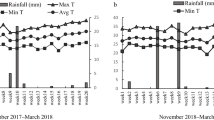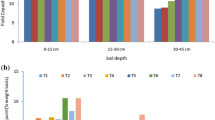Abstract
Drip irrigation in dry-seeded rice (DSR) is a new water-saving cultivation technology; however, very little is known of its productivity and water-saving capacities. The study was conducted for 2 years (2013 and 2014) in a split-plot design in three replicates with treatment combinations of four irrigation regimes [drip irrigation at 1.5, 2.25, and 3.0× pan evaporation (Epan) and flood irrigation at 3.0× Epan] and three nitrogen (N) levels (120, 150, and 180 kg ha−1). Drip irrigation in DSR resulted in higher grain yield (7.34–8.01 t ha−1) than flood irrigation (6.63–7.60 t ha−1) , with water savings of more than 40 %. Water-use efficiency with drip irrigation was higher (0.81–0.88 kg m−3) than flood irrigation (0.42–0.52 kg m−3) , being highest with drip irrigation at 1.5× Epan. Root density at soil depths of 15–30 cm was also higher in drip (0.86–1.05 mg cm−3) as compared to the flood (0.76–0.80 kg m−3)-irrigated crop. This study implicated that under water-scarce scenario, drip-irrigated DSR is a profitable, and water- and energy-saving technology. This study also suggested that policy focus in future must be tilted towards the promotion of solar-operated drip irrigation in those regions, where DSR is being promoted in the face of water and energy crisis.

Similar content being viewed by others
References
Arunyanark A, Jogloy S, Wongkaew S, Akkasaeng C, VorasooT N, Wright GC, Rachaputi Rao CN, Patanothai A (2009) Association between aflatoxin contamination and drought tolerance traits in peanut. Field Crops Res 114:14–22
Barker R, Dawe D, Tuong TP, Bhuiyan SI, Guerra LC (1999) The outlook for water resources in the year 2020: challenges for research on water management in rice production. In: Assessment and orientation towards the 21st century. Proceedings of the 19th session of the International Rice Commission. Cairo: Food and Agriculture Organization, pp 96–109
Cabangon RJ, Tuong TP, Abdullah NB (2002) Comparing water input and water productivity of transplanted and direct-seeded rice production systems. Agric Water Manag 57:11–31
Camp CR (1998) Sub-surface drip irrigations: a view. Trans Amer Soc Agric Eng 45:1353–1367
Chauhan BS, Mahajan G, Sardana V, Timsina J, Jat ML (2012) Productivity and sustainability of rice-wheat cropping system in the Indo-Gangetic Plains of Indian sub-continent: issues, opportunities, and strategies. Adv Agron 23:65–112
Coelho EF, Dani Or (1999) Root distribution and water uptake patterns of corn under surface and subsurface drip irrigation. Plant Soil 206:123–136
Ercin AE, Hoekstra AY (2014) Water footprint scenarios for 2050: a global analysis. Enviro Int 64:71–82
He H, Ma F, Yang R, Chen L, Jia B, Cui J, Fan H, Xi Wang, Li Li (2013) Rice performance and water use efficiency under plastic mulching with drip irrigation. PLoS One 12:e83103. doi:10.1371/journal.pone.0083103
Hodgson AS, Constable GA, Duddy GR (1990) A comparison of drip and furrow irrigated cotton on a cracking clay soil 2. Water use efficiency, waterlogging, root distribution and soil structure. Irrigat Sci 11:143–148
Jupp AP, Newman EI (1987) Morphological and anatomical effects of severe drought on roots of Lolium perenne (L.). New Phytol 105:393–402
Kramer P, Boyer JS (1995) Water relation of plants and soils. Academic Press, New York. ISBN 0-12-425060-2
Lilley JM, Fukai S (1994) Effect of timing and severity of water deficit on four diverse rice cultivars I. Rooting pattern and soil water extraction. Field Crops Res 37:205–213
Lv GH, Kang YH, Li L, Wan SQ (2010) Effect of irrigation methods on root development and profile soil water uptake in winter wheat. Irrigat Sci 28:387–398
Mahajan G, Singh KG (2006) Response of greenhouse tomato to drip irrigation and fertigation. Agric Water Manag 84:202–206
Mahajan G, Gill MS, Singh K (2010) Optimizing seed rate for weed suppression and higher yield in aerobic direct seeded rice in north western indo-gangetic plains. J New Seeds 11:225–238
Mahajan G, Chauhan BS, Gill MS (2011a) Optimal N fertilization timing and rate in dry-seeded rice in northwest India. Agron J 103:1676–1682
Mahajan G, Timsina J, Singh K (2011b) Performance and water use efficiency of rice relative to establishment methods in northwestern Indo-Gangetic Plains. J Crop Improv 25:597–617
Mahajan G, Chauhan BS, Timsina J, Singh PP, Singh Kuldeep (2012) Crop performance and water- and nitrogen-use efficiencies in dry-seeded rice in response to irrigation and fertilizer levels in North West India. Field Crops Res 134:59–70
Mahajan G, Chauhan BS, Gill MS (2013) Dry-seeded rice culture in Punjab state of India: lesson learned from farmers. Field Crops Res 144:89–99
Malik RS, Kumar K (1996) Effect of drip irrigation levels on yield and water-use efficiency of pea. J Indian Soc Soil Sci 44:508–509
Martin D L, Dorn T W, Melvin S R, Corr A J, Kranz W L (2011) Evaluating energy use for pumping irrigation water. In: 23rd annual central plains irrigation conference. http://www.ksre.ksu.edu/irrigate/OOW/P11/Kranz11a.pdf. Accessed Dec 2012
Matsui T, Singh BB (2003) Root characteristics in cowpea related to drought tolerance at the seedling stage. Exp Agric 39:29–38
McCauley GN (1990) Sprinkler Versus flooded irrigation in traditional rice production regions of southeast Texas. Agron J 82:677–683
Morris M (2002) National Sustainable Agriculture Information Service “Solar-Powered Livestock Watering Systems” http://www.attra.ncat.org/attra-pub/pdf/solarlswater.pdf
Passioura JB (2002) Environmental biology and crop improvement. Funct Plant Biol 29:537–546
Puangbut D, Jogloy S, Kesmala T, Vorasoot N, Akkasaeng C, Patanothai A, Puppala N (2011) Heritability of early season drought resistance traits and genotypic correlation of early season drought resistance and agronomic traits in peanut. SABRAO J Breed Genet 43:165–187
Sharp RE, Davies WJ (1985) Root growth and water uptake by maize plants in drying soil. J Exp Bot 36:1441–1456
Sharp RE, Hsiao TC, Silk WK (1990) Growth of the maize primary root at low water potentials. II. Role of growth and deposition of hexose and potassium in osmotic adjustment. Plant Physiol 93:1337–1346
Sheshshayee MS, Bindumadhava H, Rachaputi NR, Prasad TG, Udayakumar M, Wright GC, Nigam SN (2006) Leaf chlorophyll concentration relates to transpiration efficiency in peanut. Ann Appl Biol 148(1):7–15
Songsri P, Jogloy S, Holbrook CC, Kesmala T, Vorasoot N, Akkasaeng C, Patanothai A (2009) Association of root, specific leaf area and SPAD chlorophyll meter reading to water use efficiency of peanut under different available soil water. Agric. Water Manag 96:790–798
Sudhir-Yadav Gill G, Humphreys E, Kukal SS, Walia US (2011) Effect of water management on dry seeded and puddled transplanted rice: part 1. Crop Performa Field Crops Res 120:112–122
Taiz L, Zeiger E (2006) Stress physiology. In: Taiz L, Zeiger E (eds) Plant physiology. Sinauer Associates Inc, Sunderland, pp 671–681
Thakur KA, Rath S, Patil DU (2011) Effects on rice plant morphology and physiology of water and associated management practices of the system of rice intensification and their implications for crop performance. Paddy Water Environ 9:13–24
Wang YB, Wu PT, Zhao XN, Li JL (2010) Development tendency of agricultural water structure in china. Chin J Eco-Agric 18:399–404
Wright GC, Nageswara Rao RC (1994) Peanut water relations. In: Smartt J (ed) The peanut crop. Chapman and Hall, London, pp 281–325
Author information
Authors and Affiliations
Corresponding author
Rights and permissions
About this article
Cite this article
Sharda, R., Mahajan, G., Siag, M. et al. Performance of drip-irrigated dry-seeded rice (Oryza sativa L.) in South Asia. Paddy Water Environ 15, 93–100 (2017). https://doi.org/10.1007/s10333-016-0531-5
Received:
Revised:
Accepted:
Published:
Issue Date:
DOI: https://doi.org/10.1007/s10333-016-0531-5




